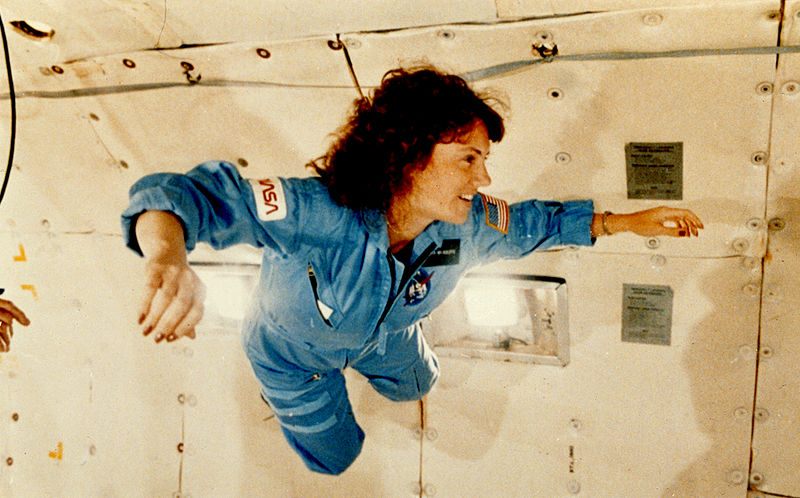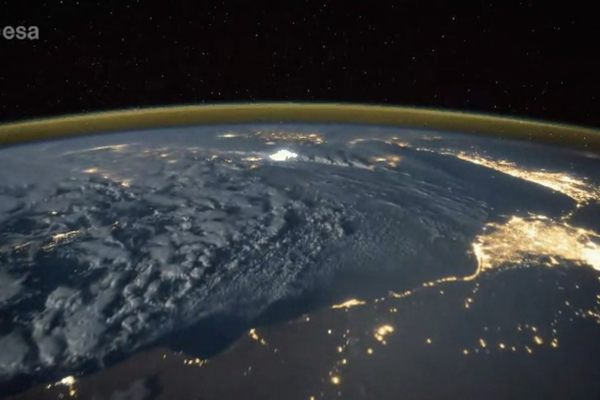Fleeting Wonders: Challenger Astronaut Christa McAuliffe’s Lost Lessons

Christa McAuliffe gets a weightlessness preview aboard the zero gravity aircraft. McAuliffe used some of her zero-G time to practice her lesson plans. (Photo: Keith Meyers/NASA Public Domain)
Thirty years ago today, the Space Shuttle Challenger exploded after takeoff, searing itself tragically into the national consciousness. Many of the Americans mourning today watched the disaster from their elementary school classrooms, and are particularly remembering Christa McAuliffe, the social studies teacher chosen from thousands of applicants to be the first civilian in space.
McAuliffe’s fans and loved ones have granted her many formal legacies–a conference, a Center for Education, even an asteroid. But there’s another way to remember the adventurous teacher. McAuliffe left a more personal legacy behind, in the form of unfinished business: eight carefully designed lesson plans, detailing the classes she meant to teach from the shuttle.

McAuliffe and Gordon practice the hydroponics experiment. (Photo: NASA)
Part of McAuliffe’s job as Teacher in Space was to “perform both live and filmed science lessons,” explains “Challenger’s Lost Lessons,” a report available on NASA’s website. Along with aerospace education expert Bob Mayfield and understudy teacher Barbara Morgan, McAuliffe developed various space-friendly lessons, dealing with everything from hydroponic bean-growing to the effects of zero gravity on simple machines. As the report puts it, “these lost lessons, prepared for the nation and world’s school children, were never done.”
The constraints of spaceflight necessitated creative solutions–all the materials required “had to fit within the confines of one mid-deck locker” about the size of a toolbox, and they had to be totally safe for spaceflight, explains Mayfield in the original plan documents.
Things that are easy on Earth–like hammering a nail into a board–were “immediately vetoed” by the commander, simply because the force involved “would have to be transmitted to either a crew member or the craft.” And, as a brief video of McAuliffe, Morgan, and Mayfield trying to work with the hydroponic chamber in Zero G shows, gardening is a lot less grounded in space.
McAuliffe, though, remained very grounded, as shown in a practice video for one of the experiments, which involved mixing liquids of different densities. After knocking a bottle to the ground by accident, she quips, “Oh, this zero-gravity environment is just awful!”
Plus, as with so much about the Challenger mission, civilian enthusiasts stepped in to help. For the hydroponics experiment, in which McAuliffe planned to test whether mung beans could be grown via nutrient misting, Disney’s Epcot Center inspired the watering apparatus, while volunteers like “John St. John, an eighth grade student from Friendswood, Texas,” helped test different plant containers.
Jerry Woodfill, a longtime NASA engineer, stumbled on these lesson plans in the mid-2000s and updated them with sketches, comments, video clips, and other supporting information, in order to make them suitable for classroom use. “Though lost in the sense that they perished with Challenger and her crew,” he writes, “recounting, redoing, and examining them is, in a sense, a resurrection.”
If you would like to resurrect one or two of these experiments on the ground, check out the eight lesson plans here (Woodfill has made them suitable for Earth). They may not be quite as wondrous on our planet as they would have been from space–but they’re some of the last homework the nation has, assigned by a brave teacher who lost her life teaching us to reach for the stars.
Every day, we track down a fleeting wonder—something amazing that’s only happening right now. Have a tip for us? Tell us about it! Send your temporary miracles to cara@atlasobscura.com.









Follow us on Twitter to get the latest on the world's hidden wonders.
Like us on Facebook to get the latest on the world's hidden wonders.
Follow us on Twitter Like us on Facebook